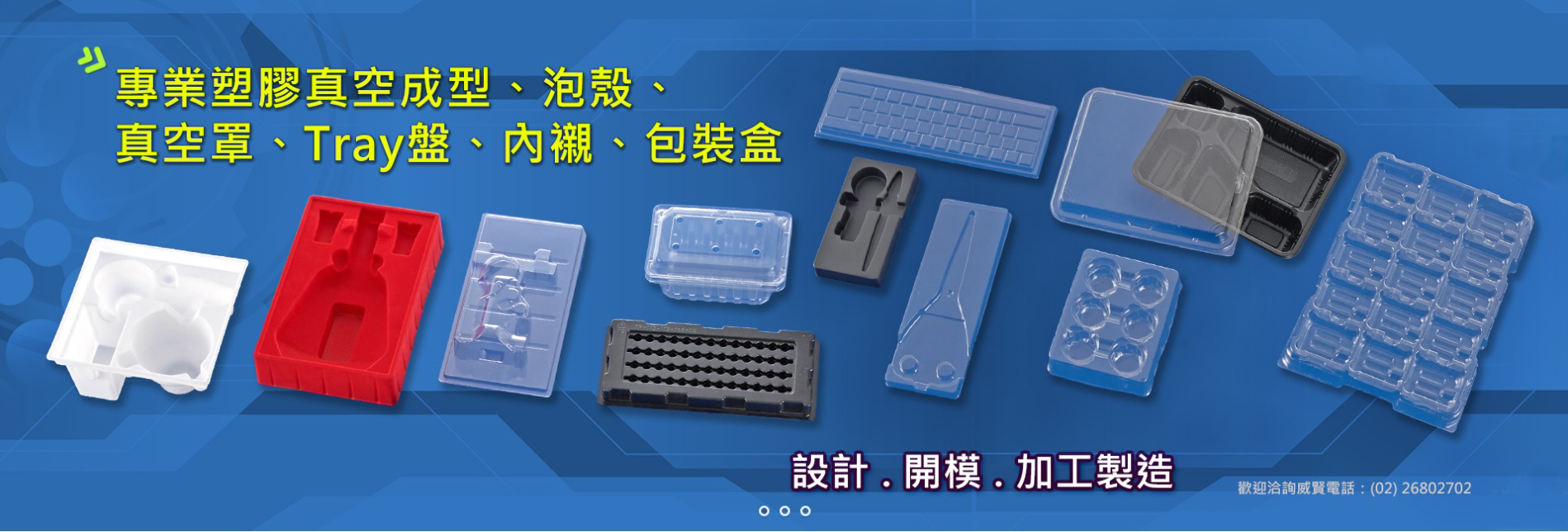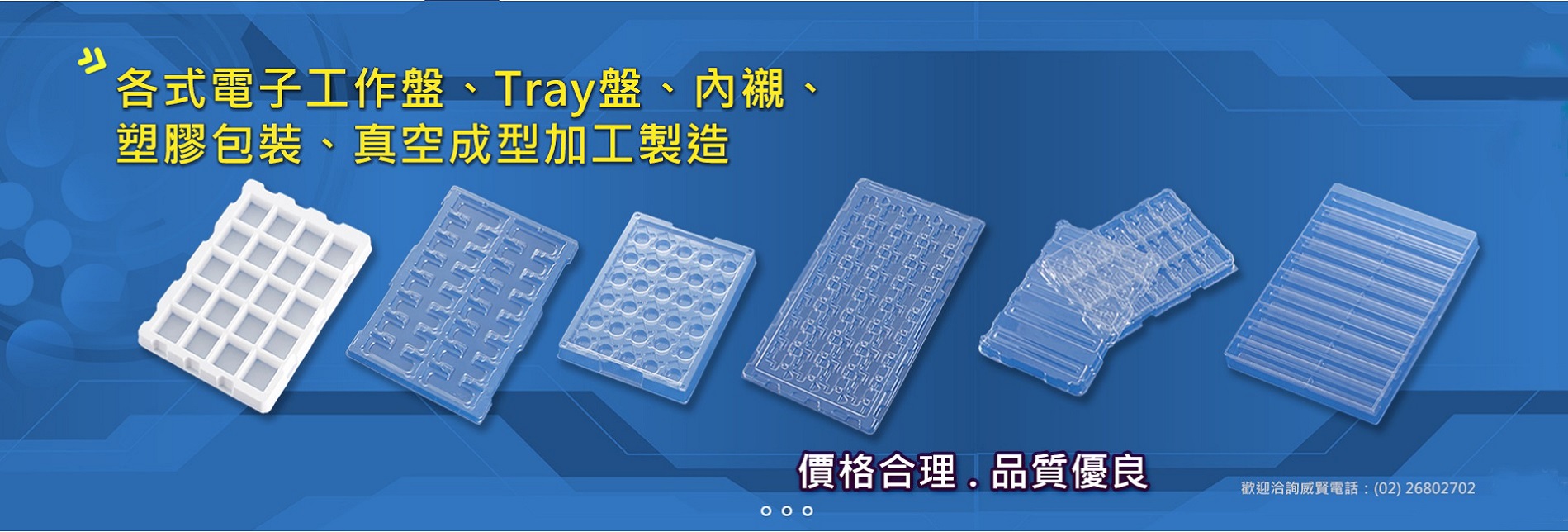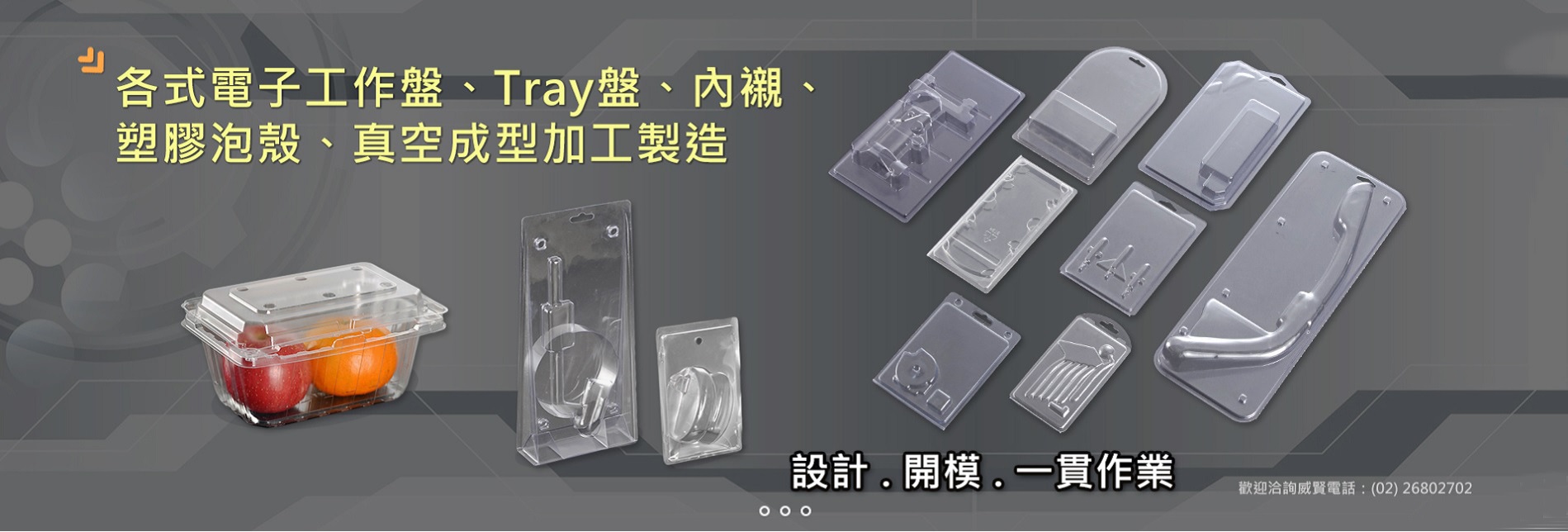真空成型
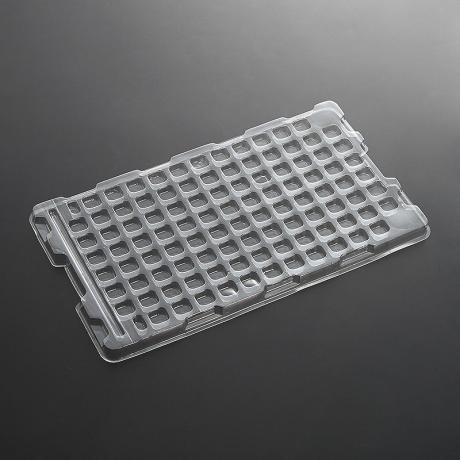 真空成型的生產過程分為五個步驟:塑膠片的加熱、吸附、成型、冷卻和脫模
真空成型的生產過程分為五個步驟:塑膠片的加熱、吸附、成型、冷卻和脫模
真空成型是一種塑膠成型工藝,它使用塑膠片材或片料在加熱軟化後,透過真空吸附在模具表面成型的過程。在成型過程中,
塑膠片料被加熱軟化後,被吸附在模具表面,接著利用真空泵將模具中的空氣排除,使塑膠片料緊貼在模具表面,冷卻後形成所需的形狀。真空成型廣泛應用於製造各種塑膠製品,如電子產品外殼、食品包裝盒、展示架等。主要用於生產各種薄壁塑膠製品,如塑膠碗、盤子、膠囊、包裝盒等。
真空成型工藝的原理是在一個真空環境下,將加熱的塑膠片吸附在一個模具上,然後通過加壓和冷卻的方式將塑膠片轉換成所需的形狀。真空成型適用於各種塑膠材料,如聚乙烯、聚丙烯、聚碳酸酯、聚苯乙烯等,而且成型速度快、成本低、產品外觀精美,是一種廣泛應用於產業界的成型技術。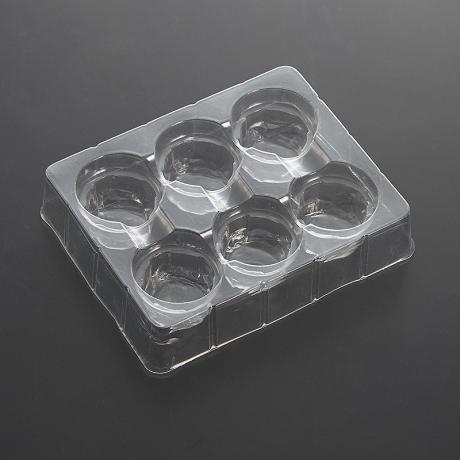 真空成型是一種常用的塑膠成型工藝,主要用於生產各種薄壁塑膠制品,如塑膠碗、盤子、包裝盒等。
真空成型是一種常用的塑膠成型工藝,主要用於生產各種薄壁塑膠制品,如塑膠碗、盤子、包裝盒等。
真空成型的生產過程分為五個步驟:塑膠片的加熱、吸附、成型、冷卻和脫模。首先,塑膠片被加熱至適當的溫度,以便在吸附到模具表面時能夠塑形。然後,模具從上方降下,將塑膠片吸附在其表面上,形成一個密封的空間。接下來,真空泵將空氣抽出密封空間,使塑膠片更加貼緊地貼在模具上。然後,模具中的加熱器通過加熱使塑膠片變得軟化,並通過壓力讓塑膠片塑形成所需的形狀。最後,模具被冷卻,使塑膠片固化,然後模具打開,產品被取出。
真空成型的優點是製程簡單、成本低廉、產品質量高、重複性好,適用於批量生產。同時,真空成型可製造各種複雜的幾何形狀,具有設計彈性,生產出的產品表面平整度高、無刺繡、無縫隙、無毛邊等優點。
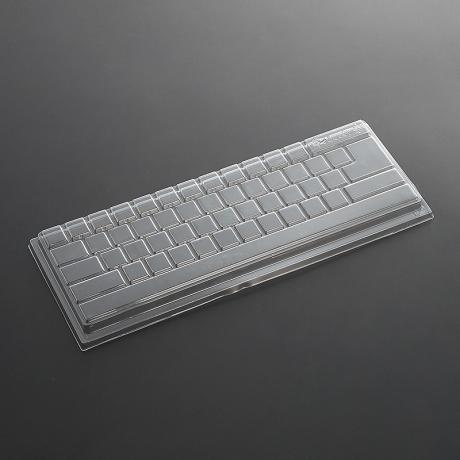 真空成型製品的應用十分廣泛,比如塑膠包裝盒、食品容器、展示架、托盤等等。真空成型是一種塑膠成型技術,通過利用熱塑性塑膠板材在高溫環境下軟化成形,再通過真空吸取塑膠板材形成模具形狀的工藝過程。真空成型技術具有速度快、生產效率高、成本低廉、製品外觀美觀等優點,因此在工業生產中得到了廣泛應用。
真空成型製品的應用十分廣泛,比如塑膠包裝盒、食品容器、展示架、托盤等等。真空成型是一種塑膠成型技術,通過利用熱塑性塑膠板材在高溫環境下軟化成形,再通過真空吸取塑膠板材形成模具形狀的工藝過程。真空成型技術具有速度快、生產效率高、成本低廉、製品外觀美觀等優點,因此在工業生產中得到了廣泛應用。
真空成型製品的應用十分廣泛,比如塑膠包裝盒、食品容器、展示架、托盤等等。相比傳統的注塑成型和壓塑成型,真空成型技術製造的塑膠製品更具有規格多樣化和小批量生產等特點,更適合生產中小規模的產品。
真空成型技術的工藝過程相對簡單,且可以將設計師的創意轉化為實際的產品,對於新產品的試驗和推廣十分重要。因此,在快速產品設計和試驗中,真空成型技術具有得天獨厚的優勢。
另外,真空成型技術的塑膠製品還可以被進一步加工,例如加工裝飾,如印刷或燙金等處理。這樣可以進一步提高產品的價值和市場競爭力。
但是,真空成型技術也存在一些缺點。首先,這種技術的運行需要大量的能源和原材料,因此對環境造成的污染也相對較大。其次,由於產品製造的一部分是手工完成的,因此成品的一些細節和品質也比注塑成型等機器化生產工藝要差。
總體來說,真空成型技術是一種非常重要的塑膠成型工藝,可以生產各種不同規格和外觀的產品。隨著技術的不斷提高和環境保護意識的提高,相信真空成型技術在塑膠製品生產中的地位將會越來越重要。
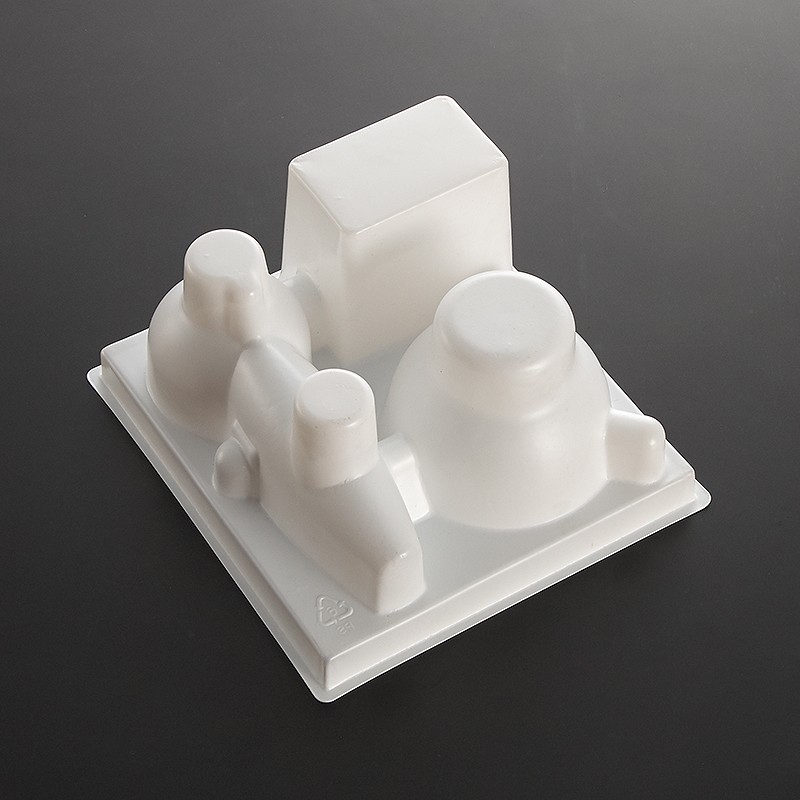 產品內襯盒是用於加強產品包裝穩定性的小工具,可以讓產品更好地展示和保護。產品內襯盒是用於加強產品包裝穩定性的小工具,可以讓產品更好地展示和保護。其中,PS是一種常用的材質,也可以根據產品需要選擇其他材質來製造。
產品內襯盒是用於加強產品包裝穩定性的小工具,可以讓產品更好地展示和保護。產品內襯盒是用於加強產品包裝穩定性的小工具,可以讓產品更好地展示和保護。其中,PS是一種常用的材質,也可以根據產品需要選擇其他材質來製造。
產品內襯盒的特性有多樣的設計方式,可以做立體包裝,還可以設計吊掛,使產品更好展示。此外,透明化的設計可以突顯產品的立體感,提高產品的附加價值。這種產品內襯盒適用於各種商品的組合包裝,例如洗面乳、化妝品、運動器材、手機、衛浴等產品。另外,產品內襯盒還可以依照產品包裝方式的不同而設計多種樣式,讓產品更好地呈現。
除了PS材質外,真空成型產品內襯盒還可以製造其他材質,例如PET、PVC、PP等等。這些不同材質的內襯盒可以應用於不同的產品上,例如化妝品展示內襯盒、五金產品內襯、電子零件內襯盒、抗靜電盒、汽車、機械五金盒、運動器材、體育用品包裝盒、食品容器盒、玩具、禮品、贈品包裝盒、各式植絨內襯盒、通信設備零件、對折盒、三折盒、手工盒、圓筒盒等等。
總之,真空成型產品內襯盒是一種可以加強產品包裝穩定性的小工具,可以讓產品更好地展示和保護。不同的材質和設計方式,可以讓內襯盒適用於各種不同的產品和需求。
真空成型(Vacuum forming)是一種熱成型技術,主要用於加工熱塑性材料,如ABS、聚碳酸酯、聚苯乙烯等。這種技術通過將熱塑性材料加熱至一定溫度,使其軟化,然後將其拉伸或吸附在成型模具上,通過真空吸附將材料吸附在成型模具上,最終形成所需形狀的產品。
真空成型過程中的主要步驟包括:
準備成型模具:選擇適合的成型模具,根據所需產品的尺寸和形狀進行調整。
加熱塑料材料:將熱塑性材料放置於加熱器中加熱,使其軟化。
吸附和成型:將軟化的材料拉伸或吸附在成型模具上,並通過真空吸附,使材料完全貼合在模具表面上。
冷卻和定型:將成型好的產品放置在冷卻機中進行冷卻,從而固定其形狀和尺寸。
真空成型具有成本低、生產效率高、產品表面平整等優點,可以用於生產各種塑料制品,如托盤、包裝盒、外殼、內飾等。這種技術在設計和製造方面具有較高的靈活性,可以根據客戶需求進行生產,同時還可以進行批量生產,從而滿足市場需求。
此外,真空成型還具有材料使用率高、生產周期短、易於操作等優點。與其他熱成型技術相比,真空成型的操作過程簡單,需要的設備和工具也比較少,因此可以降低生產成本。
然而,真空成型也存在一些缺點,例如成型產品的表面粗糙度較高、成型精度受到限制等。另外,由於需要使用真空成型機,所以成型過程受到機器尺寸和形狀的限制,無法生產較大尺寸和複雜形狀的產品。
總的來說,真空成型是一種廣泛應用於塑料制品生產中的熱成型技術,可以生產出各種形狀和尺寸的產品,並且適用於大批量生產。然而,在應用真空成型技術時,需要根據產品需求、成本和生產能力等因素進行綜合考慮,以達到最佳生產效果。
此外,真空成型的應用範圍也在不斷擴大。例如,在汽車行業中,真空成型技術可以用於生產汽車內飾件、外殼等部件;在醫療行業中,可以用於生產醫療設備、口罩等產品;在家居行業中,可以用於生產各種家居用品、裝飾件等。因此,真空成型技術在不同行業中都有著廣泛的應用前景。
值得注意的是,真空成型過程中需要注意產品的設計和選擇適當的材料。產品設計應考慮產品的功能、外觀和可制造性等方面,從而確保產品符合市場需求且易於生產。同時,材料的選擇也很重要,不同材料的特性不同,需要根據產品的需求和用途進行選擇。
總之,真空成型是一種廣泛應用於塑料制品生產中的熱成型技術,具有成本低、生產效率高、產品表面平整等優點,同時也存在一些缺點,需要根據產品需求進行綜合考慮。
Vacuum forming is a plastic molding process that uses plastic sheets or sheets to be formed on the surface of the mold through vacuum adsorption after heating and softening. During the molding process,
After the plastic sheet is heated and softened, it is adsorbed on the surface of the mold. Then a vacuum pump is used to remove the air from the mold, so that the plastic sheet adheres closely to the surface of the mold, and forms the desired shape after cooling. Vacuum forming is widely used in the manufacture of various plastic products, such as electronic product casings, food packaging boxes, display racks, etc. Mainly used to produce various thin-walled plastic products, such as plastic bowls, plates, capsules, packaging boxes, etc.
The principle of the vacuum forming process is to adsorb heated plastic sheets to a mold in a vacuum environment, and then convert the plastic sheets into the required shape through pressurization and cooling. Vacuum forming is suitable for various plastic materials, such as polyethylene, polypropylene, polycarbonate, polystyrene, etc., and has fast molding speed, low cost and beautiful product appearance. It is a molding technology widely used in the industry. Vacuum forming is a commonly used plastic molding process, mainly used to produce various thin-walled plastic products, such as plastic bowls, plates, packaging boxes, etc.
The production process of vacuum forming is divided into five steps: heating, adsorption, shaping, cooling and demoulding of plastic sheets. First, the plastic sheet is heated to the right temperature so that it can be shaped into shape when adsorbed to the surface of the mold. Then, the mold is lowered from above and the plastic sheet is adsorbed on its surface to form a sealed space. Next, a vacuum pump draws the air out of the sealed space, allowing the plastic sheet to adhere more closely to the mold. Then, the heater in the mold softens the plastic sheet through heat, and uses pressure to shape the plastic sheet into the desired shape. Finally, the mold is cooled, allowing the plastic sheet to solidify, then the mold is opened and the product is removed.
The advantages of vacuum forming are simple process, low cost, high product quality, good repeatability, and suitable for mass production. At the same time, vacuum forming can produce various complex geometric shapes and has design flexibility. The products produced have the advantages of high surface smoothness, no embroidery, no gaps, and no burrs.
Vacuum formed products are widely used, such as plastic packaging boxes, food containers, display racks, trays, etc. Vacuum forming is a plastic molding technology that uses thermoplastic plastic sheets to soften and form in a high-temperature environment, and then uses vacuum to absorb the plastic sheets to form the mold shape. Vacuum forming technology has the advantages of fast speed, high production efficiency, low cost, and beautiful appearance of products, so it has been widely used in industrial production.
Vacuum formed products are widely used, such as plastic packaging boxes, food containers, display racks, trays, etc. Compared with traditional injection molding and compression molding, plastic products manufactured by vacuum forming technology have the characteristics of more diversified specifications and small batch production, and are more suitable for the production of small and medium-sized products.
The process of vacuum forming technology is relatively simple, and it can transform designers' ideas into actual products, which is very important for the testing and promotion of new products. Therefore, vacuum forming technology has unique advantages in rapid product design and testing.
In addition, plastic products produced by vacuum forming technology can also be further processed, such as processing and decoration, such as printing or hot stamping. This can further improve the value and market competitiveness of the product.
However, vacuum forming technology also has some disadvantages. First of all, the operation of this technology requires a large amount of energy and raw materials, so it causes relatively large pollution to the environment. Secondly, because part of the product manufacturing is done by hand, some details and quality of the finished product are also inferior to machine-made production processes such as injection molding.
Generally speaking, vacuum forming technology is a very important plastic molding process that can produce products of various specifications and appearances. With the continuous improvement of technology and the improvement of environmental protection awareness, it is believed that vacuum forming technology will play an increasingly important role in the production of plastic products.
Product lining boxes are small tools used to enhance the stability of product packaging, allowing products to be better displayed and protected. Product lining boxes are small tools used to enhance the stability of product packaging, allowing products to be better displayed and protected. Among them, PS is a commonly used material, and other materials can also be selected according to product needs.
The product lining box has various design methods, it can be three-dimensional packaging, and it can also be designed to be hung to better display the product. In addition, transparent design can highlight the three-dimensional sense of the product and increase the added value of the product. This kind of product-lined box is suitable for combination packaging of various commodities, such as facial cleanser, cosmetics, sports equipment, mobile phones, sanitary ware and other products. In addition, product lining boxes can also be designed in a variety of styles according to different product packaging methods to better present the product.
In addition to PS material, vacuum formed product lining boxes can also be made of other materials, such as PET, PVC, PP, etc. These lining boxes of different materials can be applied to different products, such as cosmetic display lining boxes, hardware product linings, electronic parts lining boxes, anti-static boxes, automobiles, machinery hardware boxes, sports equipment, and sporting goods packaging boxes , food container boxes, toys, gifts, premium packaging boxes, various flocking lined boxes, communication equipment parts, half-fold boxes, three-fold boxes, handmade boxes, cylindrical boxes, etc.
In short, the vacuum formed product lining box is a small tool that can enhance the stability of product packaging and allow products to be better displayed and protected. Different materials and designs can make lining boxes suitable for various products and needs.
Vacuum forming is a thermoforming technology mainly used to process thermoplastic materials, such as ABS, polycarbonate, polystyrene, etc. This technology works by heating the thermoplastic material to a certain temperature to soften it, and then stretching or adsorbing it on the forming mold. The material is adsorbed on the forming mold through vacuum adsorption, and finally the product of the desired shape is formed.
The main steps in the vacuum forming process include:
Prepare the forming mold: Select a suitable forming mold and adjust it according to the size and shape of the desired product.
Heating plastic materials: Place thermoplastic materials in a heater and heat them to soften them.
Adsorption and forming: The softened material is stretched or adsorbed on the forming mold, and through vacuum adsorption, the material is completely attached to the surface of the mold.
Cooling and shaping: Place the formed product in a cooling machine for cooling to fix its shape and size.
Vacuum forming has the advantages of low cost, high production efficiency, and smooth product surface, and can be used to produce various plastic products, such as pallets, packaging boxes, shells, interiors, etc. This technology has high flexibility in design and manufacturing, can be produced according to customer needs, and can also be mass produced to meet market demand.
In addition, vacuum forming also has the advantages of high material usage, short production cycle, and easy operation. Compared with other thermoforming technologies, vacuum forming has a simple operation process and requires less equipment and tools, thus reducing production costs.
However, vacuum forming also has some disadvantages, such as high surface roughness of the molded products and limited molding accuracy. In addition, due to the need to use a vacuum forming machine, the forming process is limited by the size and shape of the machine, making it impossible to produce products of larger sizes and complex shapes.
In general, vacuum forming is a thermoforming technology widely used in the production of plastic products. It can produce products of various shapes and sizes and is suitable for mass production. However, when applying vacuum forming technology, comprehensive considerations need to be made based on factors such as product demand, cost, and production capacity to achieve the best production results.
In addition, the scope of application of vacuum forming is also constantly expanding. For example, in the automotive industry, vacuum forming technology can be used to produce automotive interior parts, shells and other components; in the medical industry, it can be used to produce medical equipment, masks and other products; in the home furnishing industry, it can be used to produce various Household items, decorative pieces, etc. Therefore, vacuum forming technology has broad application prospects in different industries.
It is worth noting that the vacuum forming process requires attention to product design and selection of appropriate materials. Product design should consider aspects such as product functionality, appearance, and manufacturability to ensure that the product meets market demand and is easy to produce. At the same time, the selection of materials is also very important. Different materials have different characteristics and need to be selected according to the needs and uses of the product.
In short, vacuum forming is a thermoforming technology widely used in the production of plastic products. It has the advantages of low cost, high production efficiency, and smooth product surface. It also has some shortcomings that need to be comprehensively considered based on product needs.

